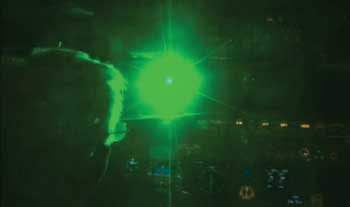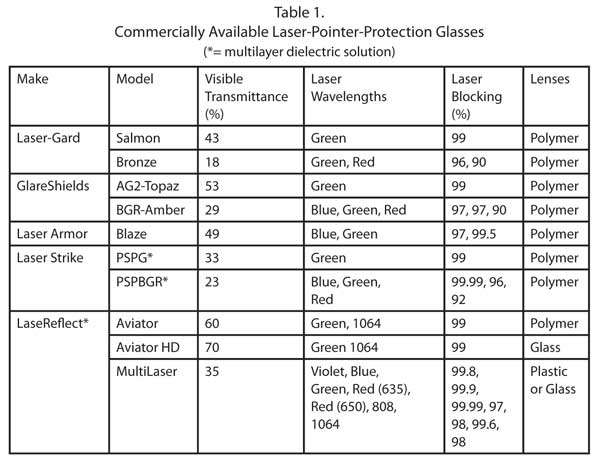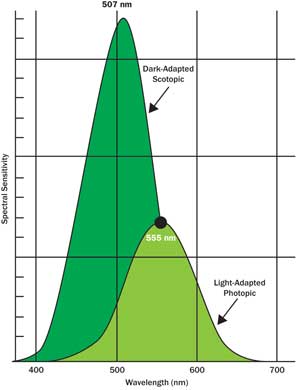Jason Palidwar, Iridian Spectral Technologies
A basic news search for “laser pointer” returns a disturbing number of hits detailing incidents in which pilots or train conductors, law enforcement personnel, politicians and athletes have been targeted by readily available laser pointers. The headlines seen here are a small sample illustrating the growing occurrence and impact of laser-pointer attacks. The Federal Aviation Administration’s Laser Safety Initiative enumerated 3482 reported incidents on pilots in US airspace in 2012 alone. No actual accidents have yet been attributed to laser-pointer attacks, but the glare associated with these attacks on aircraft can cause dangerous distraction or, in some instances, temporary blindness – jeopardizing crew, passengers and ground personnel as well as the vision of those attacked.

Still image from Federal Aviation Administration video illustrating a laser-pointer-illuminated cockpit.
Unfortunately, the laser pointers responsible for these incidents are cheap, readily available and, to date, legal for purchase. Although marketed as tools for use as pointers for presentations or for highlighting astronomical objects in the night sky, a combination of accidental misuse and malicious abuse has turned this technology into a potentially dangerous weapon. Legislation is being considered and implemented but is unlikely to eliminate the availability of these devices, especially from online sources.
Available protective eyewear blocks laser pointers but can compromise visibility in general, sacrificing the ability to distinguish critical lights and displays. However, new advances in thin-film coatings on glass and plastic optics allow for solutions that selectively reflect light from one or more laser pointers while providing high transmission and good color discrimination to the wearers.
The problem
Inexpensive laser pointers with up to 0.5 mW of stated power can easily be purchased in corner stores or electronics shops. As Class 3R laser devices, these so-called low-power pointers are available for general sale and use with recommendations to “avoid exposure to the beam.” The popular green laser pointers are DPSS (diode-pumped solid-state) devices often consisting of a neodymium-doped yttrium aluminum vanadate (Nd:YVO4) laser at 1064 nm, pumped by an 808-nm diode laser and frequency- doubled via a potassium titanyl phosphate (KTP) crystal, halving the wavelength to output the desired 532-nm green light. The power ratio of the 532- to 808-nm and 1064-nm radiation is approximately 1:3:9. To prevent the pump light (808 nm) as well as remaining nondoubled 1064-nm light from exiting the devices, they are designed to include a near-IR-blocking filter.
 These easily accessible, cheap laser pointers can be used either maliciously or accidentally to illuminate cockpits of airplanes (on takeoff and landing) or helicopters (in urban environments). When a cockpit is illuminated by a green laser pointer, the crew can suffer from any of four potential effects and their associated hazards:
These easily accessible, cheap laser pointers can be used either maliciously or accidentally to illuminate cockpits of airplanes (on takeoff and landing) or helicopters (in urban environments). When a cockpit is illuminated by a green laser pointer, the crew can suffer from any of four potential effects and their associated hazards:
Startle → Distraction
Glare → Disruption
Flash-blindness → Disorientation
Eye damage → Incapacitation
The effects suffered by flight crew vary with the distance of the attacker and divergence of the laser used in the attack. Typical laser pointers have a divergence of 1 mrad, resulting in potential eye hazard at approximately 50 ft, temporary flash-blindness to 250 ft, glare up to 1200 ft and distraction at distances up to 2 miles.1 Of these scenarios, the dominant threat comes from the potential hazards associated with a flight crew’s inability to safely pilot an aircraft because of disorientation, disruption or distraction.
As long ago as 2003, the US Department of Transportation conducted a study titled “The Effects of Laser Illumination on Operational and Visual Performance of Pilots Conducting Terminal Operations,”2 in which test pilots were subjected in a simulator environment to various levels of laser power while conducting takeoff/departure maneuvers. In tests with a 5-µW/cm2 level of exposure (corresponding to “glare” and the legal exposure limit in a 10-nautical-mile radius of airports), more than 33 percent of subjects reported effects including difficulty in banking properly, leveling off or dipping the nose slightly; hesitation; and even momentary loss of sight of the instrument panel. At a 50-µW/cm2 level of exposure, the effects were more severe and more common, with more than 10 percent of subjects losing sight of the instrument panel during take-off and one subject actually handing over control to the co-pilot in the simulator during visual approach (in the tests, a co-pilot was present but was not subjected to the laser effects).

This study was conducted with green laser light (532 nm), and the vast majority of the documented laser-pointer attacks on pilots occur at night and employ green laser pointers. The choice of color is motivated by the sensitivity of the eye, an important effect both to the attackers (they want to see the beam hitting the target) and to the victims. The photopic response (light adapted) of the human eye, as sensed by cone receptors, peaks at green wavelengths. This effect is further exaggerated with night vision (dark-adapted, scotopic response employing rod receptors), with the eye’s sensitivity to green light even further enhanced (Figure 23).

Illustration of the spectral sensitivity of the eye in light- and dark-adapted modes.
In a low-light scenario, this sensitivity to green light increases the likelihood of disruption resulting from glare. The green-sensitive receptors can be overwhelmed by a burst of sufficiently bright green light creating “flash blindness,” as the eye is much slower to adapt to changes in intensity or color in scotopic vision.
Although the effects observed from a “legal” laser pointer are disturbing enough, because of modification and mislabeling, these devices can be more powerful than the specified <0.5-mW eye-safety rating and may also be missing the internal 1064-nm optical filter that provides protection from more powerful and potentially eye-damaging invisible near-IR radiation.
And because of the distances involved in aviation-related laser-pointer incidents, the opportunity for eye damage resulting in incapacitation of the pilot is minimal with “legal” laser pointers. However, the potential for eye damage and the dangers from the other effects escalate substantially from higher-power laser pointers available from online sources. Online examples include laser pointers marketed at prices from $15 to $700 advertising power levels up to 2 W, with ranges of as much as 50 km. At these power levels, pointers can be used as weapons, as they can cause immediate permanent eye damage.
On the ground, law enforcement personnel face different scenarios when confronted with laser-pointer attacks, which are often in close proximity to the officer in crowd-control situations and often employ different-colored pointers (including red and the high-power blue lasers now available). Effects such as glare and startle are less critical than for transportation operators, but the chances are greater for eye damage and for the use of these pointers as true weapons.
The solutions
Legislation – either increases in penalties for misuse of laser pointers or introduction of bans on sale and possession of high-power laser pointers – seems unlikely to substantially reduce the number or severity of laser-pointer incidents, as these devices are too easy to obtain, modify and conceal. This newly emerging safety hazard is a photonic technology; the solutions to the problems it presents must also come from the world of photonics in the form of wavelength-selective protective eyewear.
The requirements for laser-pointer-protective eyewear vary for end users (for example, pilots as opposed to police) and in terms of the optical requirements, robustness and human-factor elements (comfort), and depend on the environments in which the eyewear is worn.
In aviation environments, which have dominated the reported incidents, most attacks occur at night, with green laser pointers and at distances of hundreds to thousands of feet. As these attacks occur near ground (takeoff, landing and taxi, for fixed-wing aircraft) and in urban environments, pilots may not need to wear the glasses throughout their flight, reducing the sensitivity to weight/comfort issues. Solutions for this environment must allow for safe and continued operation of the aircraft through an elimination of the effects of startle, glare and flash-blindness while not compromising the ability to read instrument controls, indicators and ground lighting. This puts a premium on high transmittance with moderate and narrow laser blocking to maintain excellent color discrimination.

Demonstration of green laser-pointer glare with and without LaseReflect glasses in front of the camera.
For police/SWAT officers, attacks occur in close proximity (feet to tens of feet) – with many different-colored lasers – and may occur at any time. As a consequence, the eyewear for this market must provide deep laser blocking over many wavelengths while preserving reasonable transmission at nonlaser wavelengths, must be lightweight and comfortable, and must also be impact-resistant because of the possibility of breakage in combat/confrontation situations.
Table 1 shows several commercially available solutions for laser-pointer protection. Unlike laser “safety” glasses, these solutions have reduced blocking levels in an effort to maximize visible luminous transmittance and the ability to easily discriminate colors. The polymer-based solutions are all rated for ANSI and EN safety eyewear requirements regarding durability.
There are two approaches to laser-pointer-protective eyewear: glasses with dye-absorbing plastic lenses and glasses with multilayer dielectric thin-film coatings on glass or plastic lenses. In the dye-based solution, polymer materials are impregnated during manufacture with a color-specific dye. In contrast, multilayer dielectric thin-film-coated glasses are created using well-established sputtering technologies to deposit robust optical coatings on the surface of the glass or plastic lenses. In the latter approach, the undesired wavelengths are reflected rather than absorbed in the plastic, reducing concerns regarding degradation in performance with time and exposure that were present in early dyed plastic glasses.
One new solution is the LaseReflect family of laser-pointer glasses from Iridian, manufactured using multilayer dielectric coatings. Developed in Canada – targeting the needs of train operators and pilots – and tested by research test pilots at the National Research Council of Canada, the glasses provide superior color discrimination and transmittance because of their steep-edge-filter performance and high transmittance. They also can provide standard laser blocking at many visible and near-infrared wavelengths and can be customized to meet evolving needs.
Unfortunately, it seems unlikely that the need for laser-protective eyewear will be going away anytime soon. Additional requirements have begun to arise for laser-protective optics to provide similar functionality to cameras and detectors in an effort to thwart attempts to incapacitate these devices with laser pointers. The photonics community will again need to develop products to address these issues.
Until then, the choices exist for victims of these attacks to adopt appropriate eyewear choices for their environments to maintain their personal safety and that of the people in their care.
Meet the author
Jason Palidwar is an account manager at Iridian Spectral Technologies in Ottawa, Ontario, Canada; email: [email protected].
References
1. Patrick Murphy (2009). Lasers and aviation safety. International Laser Display Association.
2. V.B. Nakagawara et al (2003). The effects of laser illumination on operational and visual performance of pilots conducting terminal operations (dot/faa/am/03-12).
3. S.J. Williamson and H.Z. Cummins (1983). Light and Color in Nature and Art. John Wiley & Sons Inc., New York.